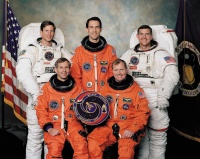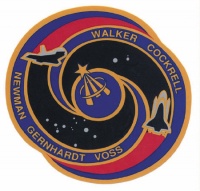STS-69
From The Space Library
 | |
| Organization | NASA-OfficeofSpaceFlight(UnitedStates) |
|---|---|
| Mission type | Human Crew,Life Science,Microgravity |
| Launch date | September 7, 1995 |
| Launch vehicle | Space Shuttle |
| Carrier rocket | {$Carrier Rocket} |
| Launch site | Cape Canaveral, United States |
| COSPAR ID | 1995-048A |
| Mass | {$Mass} |
| Experiments | Here |
| Alternate Names | OV-105,23667 |
| Nominal Power | {$Nominal Power} |
| Additional Information | Here |
| PDMP Information | Here |
| Telecommunications Information | Here |
| Data Collection | Here |
| Payload Mass Up | 11499.0 kg |
STS 69 was an American shuttle spacecraft that was launched from Cape Canaveral. Its main mission was to release and recapture Spartan 201 and WSF 2. Leading the 5 person crew was Mission Commander David M. Walker, making his fourth space flight. The Pilot for the mission was Kenneth D. Cockrell and the 3 Mission Specialists were James S. Voss, Jim Newman, and Michael L. Gernhardt. STS 69 marked the second flight of the Wake Shield Facility-2 (WSF-2), a 12-foot diameter, stainless steel disk deployed and retrieved using the Shuttle robot arm. While the WSF flew free of the Shuttle, it generated an "ultra-vacuum" environment in space within which to grow thin semiconductor films for next-generation advanced electronics. The commercial applications for these new semiconductors include digital cellular telephones, high-speed transistors and processors, fiber optics, opto-electronics and high-definition TV. The Spartan 201 free-flyer made its third flight aboard STS 69. It was a scientific research effort aimed at the investigation of the interaction between the sun and its outflowing wind of charged particles. Spartan's goal was to study the outer atmosphere of the sun and its transition into the solar wind that constantly flows past the Earth. This flight of Spartan 201 was intended to coincide with the passage of the Ulysses spacecraft over the sun's north polar region. This was also the first flight of the International Ultraviolet Hitchhiker (IEH-1), the first of 5 planned flights to measure and monitor long-term variations in the magnitude of absolute extreme ultraviolet (EUV) flux coming from the sun, and to study EUV emissions from the plasma torus system around Jupiter originating from its moon Io. Also flown aboard Endeavour was the combined Capillary Pumped Loop-2/Gas Bridge Assambly (CAPL-2/GBA) payload. This experiment consisted of the CAPL-2 Hitchhiker payload designed as an in-orbit microgravity demonstration of a cooling system planned for the Earth Observing System Program and the Thermal Energy Storage-2 payload, part of an effort to develop advanced energy generation techniques. Also a part of this payload were several Get Away Special (GAS) experiments which investigated areas such as the interaction of spacecraft attitude and orbit control systems with spacecraft structures, fluid-filled beams as structural dampers in space and the effects of smoldering combustion in a long-term microgravity environment. STS 69 was the 9th flight of Space Shuttle Endeavour and the 71st flight of the Space Transportation System.

